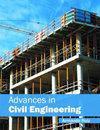地震激励下波纹钢腹板连续刚架复合箱梁桥的车桥互动动力分析
IF 1.6
4区 工程技术
Q3 CONSTRUCTION & BUILDING TECHNOLOGY
引用次数: 0
摘要
为研究地震激励下公路桥梁的车桥相互作用(VBI),提出了一种基于 Ansys 的车桥耦合分析方法。建立了 1/2 车辆模型和空间梁单元模型来分析兰州小沙沟大桥的 VBI 响应。系统的自激激励以路面不规则随机性表示,外激激励以地震表示。深入分析了地震时车桥耦合下的地震类型、地震方向、地震烈度、车速和路面不规则性对桥梁振动的影响。结果表明,地震类型对桥梁的动力响应有显著影响,最小差异为 31.4%。地震烈度与桥梁的动态响应呈正相关。与横向地震相比,纵向地震和垂直地震对桥梁垂直振动的影响更为明显。桥梁在垂直或纵向地震激励下的响应与横向地震响应的比值从 1.50 到 26.61 不等。车辆速度、道路不规则等级和随机性对地震下车桥相互作用的动态响应影响微乎其微,所占比例小于 3%。这些研究结果表明,地震-桥梁振动分析可以简化地震条件下波纹钢腹板连续刚架复合箱梁桥的 VBI 分析。本文章由计算机程序翻译,如有差异,请以英文原文为准。
Vehicle–Bridge Interaction Dynamic Analysis of Continuous Rigid Frame Composite Box Girder Bridge with Corrugated Steel Webs under Seismic Excitation
To study the vehicle–bridge interaction (VBI) of highway bridges under seismic excitation, a vehicle–bridge couple analysis method based on Ansys is proposed. The 1/2 vehicle model and space beam element model were established to analyze the VBI response of Lanzhou Xiaoshagou bridge. The self-excited excitation of the system is represented by road surface irregularity randomness, while the external excitation is represented by an earthquake. The impact of seismic types, seismic direction, seismic intensity, vehicle speed, and road surface irregularity on the bridge vibration under the vehicle–bridge coupling during an earthquake is thoroughly analyzed. The results reveal that the type of earthquake significantly influences the dynamic response of the bridge, showing a minimum difference of 31.4%. The intensity of the earthquake is positively correlated with the dynamic response of the bridge. Longitudinal and vertical earthquakes have a more noticeable effect on the bridge’s vertical vibration compared to lateral earthquakes. The ratio of the bridge response under vertical or longitudinal seismic excitation to the response of lateral earthquakes ranges from 1.50 to 26.61. Vehicle speed, road irregularity grade, and randomness have a negligible impact on the dynamic response of vehicle–bridge interaction under an earthquake, accounting for less than 3%. These findings indicate that the analysis of earthquake-bridge vibration can simplify the VBI analysis for continuous rigid frame composite box girder bridges with corrugated steel webs under seismic conditions.
求助全文
通过发布文献求助,成功后即可免费获取论文全文。
去求助
来源期刊

Advances in Civil Engineering
Engineering-Civil and Structural Engineering
CiteScore
4.00
自引率
5.60%
发文量
612
审稿时长
15 weeks
期刊介绍:
Advances in Civil Engineering publishes papers in all areas of civil engineering. The journal welcomes submissions across a range of disciplines, and publishes both theoretical and practical studies. Contributions from academia and from industry are equally encouraged.
Subject areas include (but are by no means limited to):
-Structural mechanics and engineering-
Structural design and construction management-
Structural analysis and computational mechanics-
Construction technology and implementation-
Construction materials design and engineering-
Highway and transport engineering-
Bridge and tunnel engineering-
Municipal and urban engineering-
Coastal, harbour and offshore engineering--
Geotechnical and earthquake engineering
Engineering for water, waste, energy, and environmental applications-
Hydraulic engineering and fluid mechanics-
Surveying, monitoring, and control systems in construction-
Health and safety in a civil engineering setting.
Advances in Civil Engineering also publishes focused review articles that examine the state of the art, identify emerging trends, and suggest future directions for developing fields.
 求助内容:
求助内容: 应助结果提醒方式:
应助结果提醒方式:


